Cheering Up For Christmas With Bill Reiter
Saturday, December 09, 2006
 While I have been in Vancouver for 32 years I have never been able to adapt to the shortening of days in November and December. By 7:30 last night I was overcome by sleep while reading a book. Luckily the late November depression begins to be relieved in December by thougths of Christmas and the bright Christmas lights. When December 21 comes around, I forget completely about it being the shortest day of the year. Part of my Christmas cheer comes from remembering the funiest Vancouverite and the funniest radio program I ever heard.  That was CBC's Doctor Bundolo's Pandemonium Medicine Show. And the funniest character of the show was Bill Reiter. I would venture to say that even now (although many people would not know this) Bill Reiter's voice is the most recognizeable voice of British Columbia. His voice is heard in countless voice-overs and commercials.
A Christmas Story - A First Time, Again
Friday, December 08, 2006
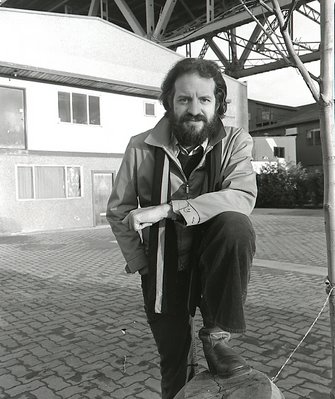
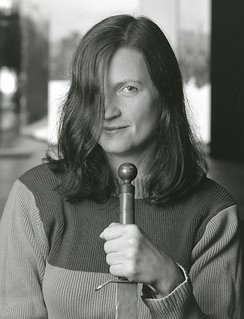
Listening to a relatively obscure Beethoven bagatelle on the radio some years ago while driving made me stop the car and I had to park it. I had never heard it before. It was exquisite. I found the need to call someone who understood. I called my VSO pianist friend Linda Lee Thomas. Her husband, Vancouver Chamber Orchestra director, Jon Washburn (below left, Linda Lee right) answered the phone. So I told him of my sonic "on my way to Damascus" adventure. He commented:
"Ah, Alex, I envy you for being able to listen to something for the first time."
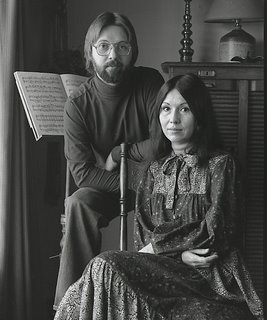
What he said really did not hit home until my attendance this Wednesday with my granddaughter Rebecca (9) of the Arts Club Theatre Company's presentation of A Christmas Story.
My connection with the Arts Club began around 28 years ago when Vancouver Magazine editor Malcolm Parry told me, "We are working on a story on the movers and the shakers of culture in Vancouver. Go and photograph the venues and the players." Linda Lee Thomas and John Washburn were a couple of them. Another player was a new man in town who had a vision of starting a new theatre on Granville Island that would replace the aging converted gospel hall at Seymour and Davie. That's how I met Bill Millerd (the current Artistic Managing Director) and photographed him (above, left) in front of the soon-to-be-converted building that was to become the Granville Island Stage of the company.
In July 2002 I photographed director Katrina Dunn (top, right) at the Bard on the Beach. Perhaps the little smile of the picture was a hint then, that she could not only direct a Shakespeare play but also direct to please children.
Rebecca (below) went to her first opera, Monteverdi's The Coronation of Poppea, when she was 5, but somehow I never managed to take her to a play until this Wednesday. It was the right play. Her smiles, her giggles, her laughs made me experience going to the theatre for the first time.
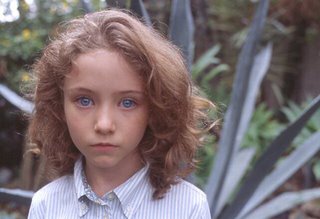
Perhaps I could teach Jon Washburn a few things about listening or seeing something for the first time, through the eyes of a child.
A Christmas Story
She Wrote
Thursday, December 07, 2006
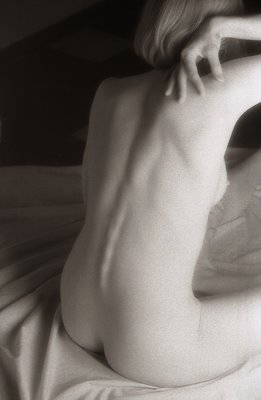 Posing For Alex
When I learned of the opportunity to pose nude for a joint photo/writing project with Alex, the first thing that came to mind were black-and-white images of beautiful women a former boyfriend had taken. A talented photographer outside his day job, he chose nude women as his preferred subject matter. His shots, some of which hung on his living-room walls, were erotic not pornographic, tasteful not tacky.They also made me crumple.
Instead of seeing pieces of art, I saw women far more appealing–far more lovely and gorgeous and smooth and delicate–than I would ever be. He never compared me to the women who modelled for him, but I did. “I’ll never look like that,” I thought. I turned those images into direct comments on my own body. I would obsess on my small-ish breasts and a less-than-smooth butt. I allowed his photos to make me feel inferior, inadequate, sometimes ugly. Once or twice the photos reduced me to tears.
So the prospect of putting myself in front of another photographer’s camera, unclothed, was daunting. If I was so aware of my self-perceived flaws in front of the mirror, surely they would be the first thing I’d notice in stark black-and-white prints. In revealing my imperfect body to this artist–also male–I would be unveiling not only my physical imperfections but also my emotional vulnerability. Alex left the choice up to me. He never tried to persuade me to do something I didn’t want to do. It helped that he is a professional with a solid track record–he’s photographed Evelyn Hart and has had his work in publications like Readers’ Digest. I knew I could trust him–and ultimately, that trust made our time together work.
I knew he had no ulterior motives or inappropriate goals. I knew he wasn’t some dirty old man looking for an excuse to see some flesh, or worse, to try and get me in bed. He wasn’t out to create soft porn. I wouldn’t have said Yes if I felt the least bit wary of his intentions, and I’d never put myself in a similar position, so to speak, with someone who I felt lacked professionalism, skill, and integrity. The project depended as much on his technical ability as his interpersonal skills. And given his breadth of experience, I knew he would find a way to make me feel as comfortable as possible. We had a purpose, and we had to work as a team.
So as much as the session was a challenge, it was also an opportunity. It was a chance for me to face my fears. And it was a chance for me to say to someone–and to myself–this is the real me. It was a very real test to see if I could put my insecurities to rest.
As a rookie “model”, I didn’t know exactly what to expect or how to prepare. I had envisioned Alex’s studio as a small, semi-swank joint given its Robson Street address instead of the sparse grey room with a faux brick fireplace in a creaky old building. Two of his portraits hung on one wall. Perhaps the room’s unpretentious ambiance helped create a relaxed mood. It also helped that we chatted about that day’s peace march and weather before determining, together, where to start. We picked a theme: a dancer portrayed in “undancerly” poses. We flipped through a book of Edgar Dégas paintings to generate ideas but not to pick a pose to re-create. We began with me in my favourite pair of jeans. It wasn’t so bad to stand in front of a single light and a camera without a shirt on– if I was going to spend an afternoon in the buff I might as well lose any sense of discomfort or embarrassment from the top. But I would be lying if I said I didn’t feel any apprehension. That said, the situation never felt horribly awkward. Alex was encouraging when it came to coming up with specific poses without being condescending or overbearing. We seemed to have a mutually respectful rapport that included rational, intelligent dialogue.
Once we’d decided on a pose, Alex would set up the shot and take a Polaroid before using “real” film to make sure the image was one we were both happy with. Having a good idea of what the final product would look like was incredibly helpful; I didn’t have to worry that the results would be horrible. And Alex had assured me that if he couldn’t make a pose look good, we wouldn’t do it.
My voice of insecurity whispered a bit louder when it came time to strip to the raw. We joked a bit about this being the “embarrassing” part. For about half a minute I did feel embarrassed about standing fully naked in front of Alex. Still, his easy, professional manner put me at ease. And I think he was probably more embarrassed to learn that I’m an advocate of Brazilian waxing–than I was to show him my bare bum.
I had long wondered whether such a situation would be erotic for either the artist or the subject. I can’t speak for Alex, but for me, although the experience can be a sensuous one in fantasy, it wasn’t in real life. Maybe I was too consumed with trying to do a good job. However, for a few brief instances, like when I was lying on a silk sheet, I felt like the one of the most beautiful creatures on earth.
There were niggly things about the session, like me being too hot then too cold. We didn’t play any music because it was more of a distraction than anything. One thing I hadn’t anticipated was fatigue. We spent nearly five hours together. I didn’t think about the experience actually involving some “work” on my part. But posing took concentration and patience and creativity and openness; about three-quarters of the way through I started to run out of steam. I imagine that Alex felt the same way.
In retrospect, I wish I had been more bold or inventive with poses, but at the time my level of confidence would only go so far. The fact that I was able to pull it off–no pun intended–was an enormous accomplishment.
I took six Polaroid images with me after we were done. In two, the first thing I notice are what I perceive as flaws. In four, I think I look pretty good. Some day I might even think I look hot.
I’m grateful I had a chance to work with a photographer I respect and whose work I admire. In that regard, the session was an honour. I’m also thankful I’ll have lasting images of me at this stage of my life. When I’m 90 and wishing I could still dance, I’ll have these reminders of the way my body used to be, the way I used to look. I’m sure then I’ll think how ridiculous it was for me to feel anything but radiant.
Like any experience, fine details fade away. But what lingers after this session with Alex are two qualities that seep into other areas of life: how important trust is in a personal relationship, and how crucial self-love is to begin with.
I Wrote
I wrote, She wrote
I Wrote
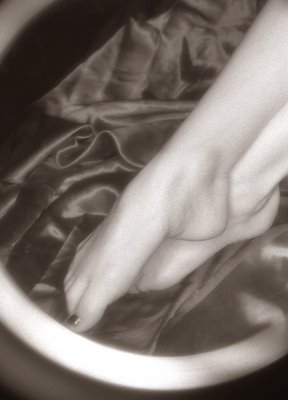 The Tension is There
It was a combination of the anticipation of a sexual interaction with someone unknown and what I was going to do with her that had me not sleeping nights waiting for my 4 pm, January 18, 2003 appointment with Joanne Chabot.
Joanne is a 33-year-old writer with a ballet background. I know her professionally. She was coming to my studio to pose nude for my camera. I have photographed many women and quite a few men in the nude. But still each one provides me with pleasure, surprise, and excitement– similar to the feeling of anticipating one of my photographs on the cover of a magazine. Even after a few hundred covers the thrill is always there.
Just like at one time people said they bought Playboy to read the articles, there are photographers who say they like to shoot nudes because they like the simple and compound curves of the human body. They say the body can be abstract or can resemble a sand dune. They may be right but I would point out that ostriches and skunks are also made up of curves... And sand dunes don’t charge by the hour.
I like to shoot nudes because I am attracted to the human body. It’s a myth that there is no sexual interplay in figure photography. There is. And it is because of this sexual conflict that the photographer must practice special care.
Elliott Erwitt, on a Life Magazine assignment to photograph an open-heart operation, decided to watch a day before the shoot. As soon as the patient was opened up Erwitt promptly fainted. The surgeon had second thoughts in allowing Erwitt back but Erwitt asserted, “I’ll be fine tomorrow, my camera will be my barrier.” And so it was.
And so it is with nude photography. If your subjects trust you, like patients with their doctor, they’ll allow you to peek into their soul. Through mutual trust you can sometimes reveal the subject’s most intimate emotions. This professional relationship can be fragile when your subject is nude.
The best piece of advice I ever got on the subject was, “ If you don’t plan to take photographs, don’t take your camera.” There seems to be a long running cliché that photographers do it more often. Could it be that there is the pressure to overtly make a pass at the model in an intimate photo session? The idea that women are turned on by photographers was popularized in Michelangelo Antonioni’s 1966 film Blow Up. Verushka, the super model of her time, seemed to achieve sexual climax at the feet of camera toting David Hemmings on his studio floor. I can feel sexual tension when I photograph my nude subjects. I think this tension helps in the taking of the photographs. I allow it to remain. Touch could make it crumble.
I told Joanne to change in a special cubicle I have in my studio just for that. The idea of telling an almost complete stranger to strip in front of the camera is not only difficult for the subject but for me the photographer, too. Since I was formed firmly in the 20th century I do not have the carefree approach to nudity that the younger Joanne seemed to have. She removed her clothes in my presence, and I chose to do the gentlemanly thing and I turned around.
There are some who believe that with a model in front of your camera all you need do is click the shutter and the model will do the rest. This rarely happens but if you watch your models during rest periods they invariably strike a good pose. I like to pre-conceive my photographs and I use a couple of tricks that have served me well. One of them involves the idea of the narrative. Can I take 5 pictures that will tell a story when placed in a row? I think of an introduction shot, a strong central shot, a fun shot picture that may run after the first shot and at the end (a profile) looking at the previous 4 pictures. I always pick a theme and work around it. I knew Joanne was a dancer and as such I could feature her graceful hands.
Usually I don’t experiment with new techniques, new film combinations, or use tricky lighting with a model I have not photographed before. For the first session I keep it simple. I like to use one soft light. By using a reflector or moving my subject close to a white wall or away I can control contrast. I will take with a main camera loaded with normal B+W film, and load a 35mm camera with B+W infrared to supplement the pictures, because I like what that film does to skin. I don’t believe that bad photographs can be fixed later. They have to be near perfect from the beginning. If you cannot correct the problem it is best not to shoot it.
Sometimes the reason for not shooting is more than just technical. In 1990 I faced noted writer George Plimpton. I was awed. Plimpton shared a story with me that broke the ice. “Years ago when Muhammad Ali was known as Cassius Clay, the boxer lay defeated in his dressing room after having been out punched by Frazier. Photographer Gordon Parks and I were covering the event for Life. Gordon raised his Nikon to his eye and what he saw was defeat. It almost looked like the corpse of Che Guevara on the marble slab of that Bolivian morgue. He lowered his camera and looking at me he said, ‘I can’t do it.’ And he didn’t.”
I always have Plimpton’s story in my mind. The photographer has to respect his subject, particularly one who may be in a vulnerable position. Being nude in front of a camera surely is. For some models certain parts of the body are okay to be photographed, others are not. If I disagree I sometimes will take a Polaroid (which as a record can be destroyed) and sometimes my model will come around. But if they are adamant I must respect the choice and refrain from shooting. The camera is a barrier but it shouldn’t be so opaque as to prevent us from seeing and thinking of what we are doing.
She Wrote
I wrote, She wrote
Ray Smith & Adam Zimmerman - Two Gentlemen Forestry Barons
Wednesday, December 06, 2006
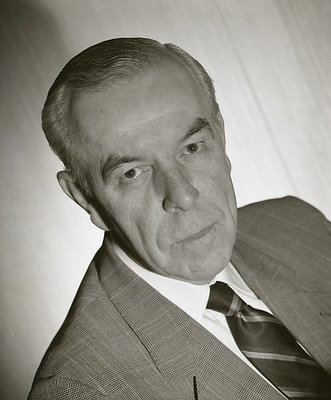
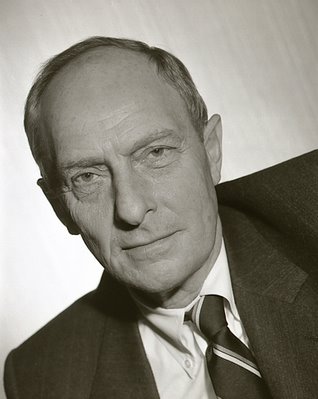
A couple of years before my Vancouver photographer friend Fred Schiffer died in 1999 we had a project going. It had all started when we were looking at picture books of Vancouver architecture. One of them was the book Bridges of Light, Cyril E. Leonoff's book on Vancouver architecture photographer Otto Landauer.When he looked at all the famous Vancouver landmark buildings he said to me in his perfect Argentine Spanish, "Otto photographed the buildings and I photographed the architects and the men that put the money to build them." We started comparing notes and we realized that both of us had photographed the same architects and CEOs but at different times. He did most in the 60s and 70s and I began in the 89s. Fred Schiffer had pictures of architect Arthur Erickson where he looked like a dashing matinee idol. With Fred's death our show never happened.
With the advent of the digital camera and the postage stam sized web page photos of executives, the "executive" portrait has gone in decline as quickly as the fortunes of the photographers whose mainstay were annual reports. I did my share in my time and a company I remember fondly is Macmillan Bloedel. It was their advertising and marketing chief T. J. McDowell who gave me my first commercial job in 1977. With more recent revelations on how this company did indiscriminate clear cutting of BC forests all I can say is that my rosy memory has all to do with two men who ran the company for almost 10 years. One of them was the urbane CEO of Noranda, Adam Zimmerman and the other was the tall and large handed Ray Smith who never seemed to know what to do with them.
I genuinely liked them both as I got to photograph them every year for almost 10 years. In one occasion they entered the board room (which had a prominent painting of the founder of the company, H.R. Macmillan). Both had cigars. I looked at them and I said, "Gentleman, you both have very good taste as those are Montecristo Claros."
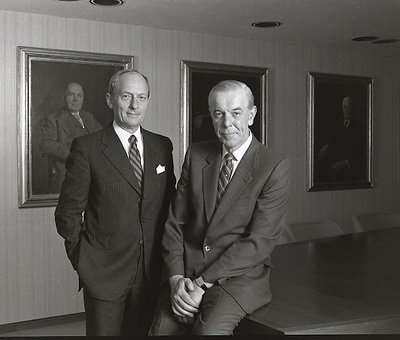 |
| H.R. MacMillan in portrait behind |
They looked at me in surprise and smiled. I had Ray sit on the boardroom table and I placed an ashtray behind him so that both could use it. They were so happy that they did not have to abandon their cigars, that they gave me full cooperation. I would take a couple of photographs. Then they would puff on their cigars. We did this for some time as I took 20 exposures.
Boot Camp Instincts - Molly Parker & Lynne Stopkewich
Tuesday, December 05, 2006
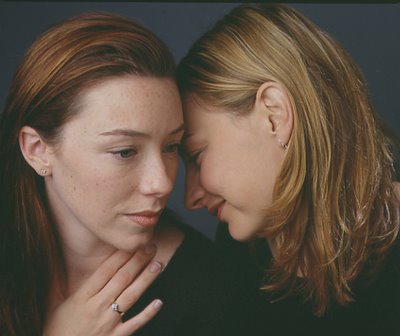
Every month, sometimes every couple of weeks, I take the best photograph of my life. We photographers share a situation with 19th century American gunslingers. If our shot isn’t good enough we are dead. If we rest in our laurels boot hill awaits.
Every moment, every exposure in photography, precedes intense training. Boot camp teaches soldiers to forget their instinct for self-preservation. When they are ordered to advance into enemy gunfire they do not flinch. Photographic basic training helped me on September 24, 2000. I took a picture I have never topped.
We are born, we grow, mature, age and we die. Life holds us to that inescapable pattern unless we die young. An inescapable pattern haunts photographers, too.
In I962 I was 20 and living in Mexico City. A German friend and I would go on shooting sprees. We loaded our Pentaxes, Pentacons and Edixas with Tri-X or Agfa Isopan Record, a film that could be pushed to 1200. We eschewed filters since we did not believe in modifying what we saw. We were too young and ignorant to know of the blue sensitivity of b+w panchromatic film. We photographed native Mexican women in markets with their piles of exquisitely ordered oranges and Mexicans looking out of windows or standing in doorways. We photographed beggars and dirty children.
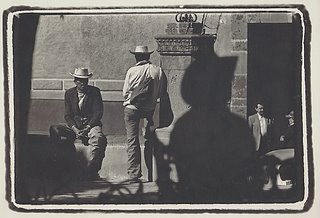
We thought all this was avant-garde. The use of flash (which we couldn’t afford) modified existing light and was anathema to our authenticity code. We never shot posed portraits because that was unnatural. Our people shots were exposed on the sly.
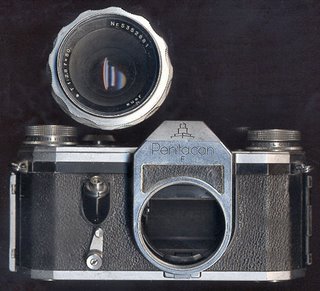
Since then I have used slide film, negative film, I have put photographic paper and Cybachrome as film in my cameras. I have used a 4x5 camera, swivel lens panoramic cameras in several formats, pinhole cameras, cheap cameras, and box cameras. I have placed my face on my Epson scanner. I use studio flash as a hard light with a ring flash with optical or Fresnel lens spotlights and as indirect with umbrellas and soft boxes. I have opened Kodak B+W Infrared 35mm film canisters in daylight and suffered the consequences. I have incorrectly loaded film more times than I care to admit into my Pentaxes and Nikons so that it won’t advance. Years ago I cross processed E-4 and used Dektol straight on Tri-X at 4000 ISO. I remember my first nude.
My Mexico City youth came to haunt me. Before Saturday Night died (yet one more time), I battled with young female photo editors who wanted me to shoot ”loose from the hip.” I was to be, “a fly on the wall” and ordered not to light or use a stylist. They wanted the pictures to be “edgy” and high contrast. Had I taken them with my long lost Edixa and Isopan Record, overexposed it (I used to guess my exposures) and printed on Agfa Brovira Number 5, the paper of my youth, I would have made friends and perhaps more money.
I believe that every photographer has to repeat this pattern in some way until technique is no longer a primary concern. It’s there like basic training ready to kick in when needed. I must not criticize sunset photographs or cat photographs because I may have done them in my past. If shooting a nude as a landscape is how we all begin (and as I began), I cannot expect a young photographer to skip that stage. We all have to shoot that pyramid of oranges on the market square.
When film director Lynne Stopkewich and actor Molly Parker walked into my studio on September 24, 2000 I had only one mission and that was to explain with one photograph my suspicion that a special bond existed between them. This bond had allowed them to make Kissed and the then yet-to-be released Suspicious River. Both films conveyed to me an almost alien point of view. I realized that this disturbing yet refreshing feeling was that both films were made with a woman’s point of view. I had been disappointed in the past by the films of American director Katheryn Bigelow as well as those by Nora Ephron. Molly Parker’s performance in Suspicious River is so astounding that I wanted to show in a photograph the invisible bond that must exist between the two women.
I exposed several Polaroids. None worked. During a rest period I watched them and then I saw it. I took a Polaroid. I showed it to them and they nodded. We took a few photographs and quit.
It’s not important what kind of camera, film, or technique I used. What is important is that when I saw my shot, technique was far in the background and I had only to follow my boot camp instincts and press the shutter. Those young Saturday Night photo editors may have been trying to tell me something. Just like soldiers and officers must invariably return to practice their basic training with regularity we photographers must go back to our roots and just shoot, technique be damned.
Sherlock Holmes, Dylan Pflug & The Story Of The Dancing Men
Monday, December 04, 2006
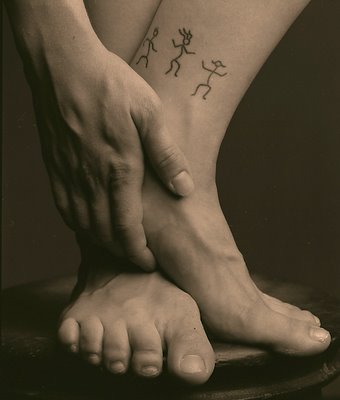 I look forward to the day that I can watch Beau Geste (with Gary Cooper) at home with Rebecca. At 9 she may not be ready for the complex plot of this film that I saw at about that age in Buenos Aires. The scene with all the dead legionaires propped up behind the parapets to defend Fort Zinderneuf left me with a shock of memory I will never forget. So for our Saturday evening home viewing with Rebecca I chose Barry Levinson's 1985 Young Sherlock Holmes better named in Britain as Young Sherlock Holmes and the Pyramid of Fear. With its Lucas Films special effects it was a perfect film for Rebecca who was rivited to the screen throughout. Even Rebecca noted that the film had similarities between the characters, setting, events and tone of Young Sherlock Holmes, and those of the Harry Potter series. Perhaps it can be explained that the first two Harry Potter films were directed by Chris Columbus who wrote the screenplay for Young Sherlock Holmes. The film "explains" several peculiarities of Conan Doyle's grown up Sherlock. 1. Holmes has started learning to play the violin during the opening scenes (frustrated he has not mastered the instrument after 3 days of practice) 2. The scar on his cheek is acquired during a fencing match with the fencing teacher and villain Rathe. 3. His deerstalker cap, belonging to his mentor Waxflatter, is given to him after Waxflatter's death. 4. His pipe is originally bought by Watson to allow them to question an antique shop dealer; in the conclusion, Watson presents it to Holmes as a parting gift. His jacket originally belonged to Rathe, and is also his first trophy. And of course the death of Elizabeth (the film's fetching young heroine) at the end of the film tries to explain Sherlock Holmes's ambivalent relationship with women. Yesterday I thought more about Sherlock Holmes and remembered dancer Daylan Pflug. I had photographed her in 2000 for the Straight. She had an odd tattoo on her ankles. They were primitive stick men. 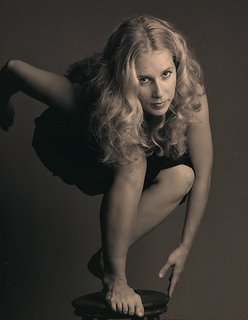  At the time I connected her stick men with the stick men of the Sherlock Holmes short story The Adventure of the Dancing Men.
Guns - Tom Bongalis, Billy Miner & A Bisley Model 41 Colt
Sunday, December 03, 2006
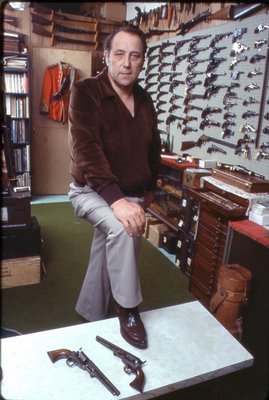
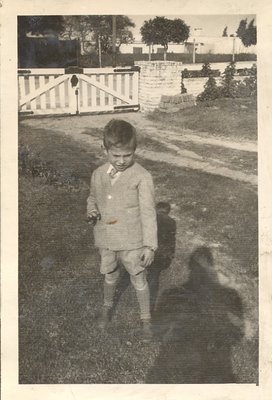
For years I have bragged that I never wanted to own a gun, a motorcycle or grow a mustache or a beard. Until I started gardening in the late 80s I was very proud of my smooth and pristine "gentleman's" hands. In short I have never been into manly symbols. But it wasn't always so.
I was born in 1942 and by September 1948 there is this photograph of me holding a gun. On September 1952, on my grandmother's birthday (she is sitting between blond me and my first cousin Wenceslao de Irureta Goyena) we are holding guns. I am holding two guns.
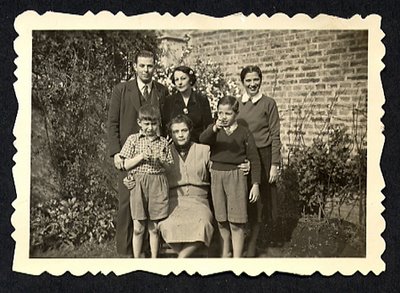
The man behind is Uncle Tony de Irureta Goyena, Wencesalao's father. In those years he would take us hunting in the jungles of the Argentine province of Corrientes. With his 22 caliber rifle he would shoot down hundreds of green parrots that he said were a menace to our aunt's crops. To this day I remember almost not being able to see the sky because of the density of the trees and the thousands of parrots that squacked loudly, and more so, after each gun blast. I was 9 and not really yet aware of what my uncle was doing. By the time I was 20 I knew that with my quick temper it would be a very bad idea to have a gun in the house. My fascination with guns became a standofish literary one.
In the 80s in Vancouver I seemed to need guns as props often. My gun provider was North Van gun collector Tom Bongalis. He seemed to understand my attraction but repulsion to guns so he never ever charged me for any of the rentals and he trusted me with valuable guns. In the late 80s I photographed him in one of his gun rooms. He had built his house with this gun collection in mind. The basement was reinforced concrete, and the entrance to this gun collection was via an antique, all-steel bank vault door. Here he is in his gun room. The Colt was train robber Billy Miner's gun.
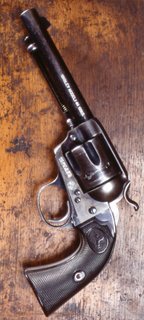
Sometime in the mid 90s Bongalis died. I wonder who now has what was then the best private gun collection in Canada.
Addendum October 10. 2007
name: Jason Bongalis
comments: Hello,
I'm writing to you to answer a question you posed
on your site. My name is Jason Bongalis, grandson
of your former gun dealer Tom Bongalis. I was
searching for some info on my grandfather and
found him on your site. As you describe him is just
as he was. Unfortunately after Tom passed the
buisness had to be shut down, and the entire
collection of guns and antiques were broken up and
auctioned off individualy. I just thought you may
want an answer to your question. I enjoyed the piece
you wrote on him, I always enjoy hearing stories of
who he was and what he did. Anyways just a quick
hello. Bye.
More guns
|



























